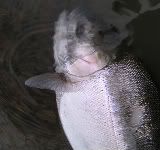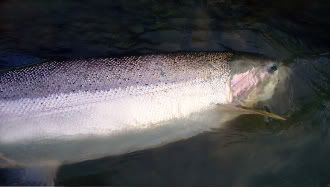In the meantime, the commercial fishing industry is in love with a few on this board.
not me, you should take the time to read this news release below, i think the part in bold stinks and i think we the sportsman should be working on ways to get more fish for us and not working to give the commercials more fish, and before you bash me, try to atleast comprehend what Pat Frazier is saying and think about what it could do to sportfishing, if you cant understand that aspect of this then you are beyond help.
August 28, 2009
Contact: WDFW Region 5 Office, (360) 696-6211
Tagged salmon may point way
to new commercial fishing gear
VANCOUVER, Wash. – Anglers who catch a salmon bearing a jaw tag or a colored “spaghetti” tag near its dorsal fin can play an important role in a new study of experimental fishing gear now under way in the lower Columbia River.
By reporting tagged fish, anglers can help researchers determine survival rates for chinook and coho salmon released from three types of commercial fishing gear being tested by the Washington Department of Fish and Wildlife (WDFW).
Anglers can keep the fish if allowed by local fishing regulations, but are asked to inform WDFW of their catch by calling the number printed on the colored tags.
“Two major goals of this study are to test the gear’s effectiveness in catching fish and to determine how many salmon survive after they are released from it,” said Pat Frazier, a WDFW fish manager who is directing the study. “Our immediate focus is on the gear’s effectiveness, but recovery of tagged fish will help to inform future studies.”
Supported by $200,000 in federal funding, the one-year pilot study will test the effectiveness of floating traps, beach seines and a modified version of the purse seine – all of which corral fish while leaving them free-swimming. Once contained, fish can be identified and released by type or species with a minimum amount of handling, Frazier said.
That is not necessarily the case with gillnets, the primary type of gear used in commercial fisheries on the lower Columbia River, which snare fish by the gills as they encounter them, Frazier said.
“The ability to release fish unharmed is important to maintaining sustainable fisheries on the Columbia River, where many runs are listed for protection under the federal Endangered Species Act,” Frazier said.
“Commercial boats could actually catch a lot more hatchery-reared salmon if we can find new ways to reduce mortalities of protected wild fish.”Working with area fishers, WDFW will conduct the pilot study through Sept. 27. Boats and gear involved in the study will be identified as part of a research project.
Frazier said the pilot study is likely just the first step in a multi-year effort to identify – and likely modify – commercial fishing gear for possible incorporation into the fishery.
“Some of this gear has been used on the Columbia and elsewhere in the past, but that doesn’t necessarily mean it will meet today’s standards,” he said. “Figuring out what works and what doesn’t is what this study is all about.”




















 Previous Topic
Previous Topic Index
Index

